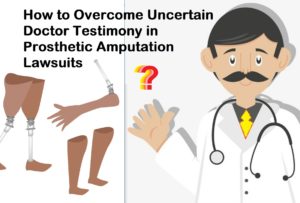This Pages Teaches:
- Amputation Definition
- Types of Amputation
- Amputation Treatment
- Managing an Amputation Claim
The amputation injury lawyers at Hamilton & Associates have special experience and skill in dealing with loss of limb cases. We have successfully compensated our clients millions of dollars for past medical treatment, future medical treatment, prosthesis, rehabilitation, and employment retraining.
Amputation lawsuits require unique experience for lawyers. Loss of limb cases are more complex than typical personal injury attorneys face, though the fault (liability) issues are the same. One alleges a work place mistake, negligence, negligence per se, product defect, or other type of accident. The difference is significant when establishing damages and client compensation.
There are unusual employment issues with limb losses. Hospital and medical damages are different with amputation cases. This is because of the particular harm that is caused to the body when a person loses a limb. This is why you will want the successful experience of the amputation injury lawyers at Hamilton & Associates to win your case.
How common are amputations?
More than 185,000 amputation surgeries occur in American each year. Over time, this has amounted to over two million Americans with amputations.
Amputations occur because of the following main causes:
- Vascular disease including diabetes = 54%
- Traumatic accidents = 45%
- Cancer = 1%
Amputations due to diabetes have increased by 25% since 1988. Of these, 71% of limb loss is due to an amputation underneath the knee.
Physicians expect a 50% rise in diabetes related amputations under the knee by 2020. The total number of individuals with losses of limbs due to amputations is predicted to double by 2015 to 3.6 million persons.
What is the cost to the United States of amputations?
The United States spends approximately 12 billion dollars per year in the treatment of loss of limb.


What are the types of amputations?
Amputations come in the following categories:
- BKA = a below the knee amputation. The most common type of limb loss is the transtibial amputation through your shin bone. Expect to walk with a prosthesis.
- AKA = an above the knee amputation. Bone is removed from the thigh and above the joint of the knee. This is also known as a “trans-femoral” procedure. These are more problematic because of the loss of control of the muscles of the upper leg. Prosthesis is difficult for AKA amputations.
- HPA = the hemipelvic amputation. Part of the pelvis is removed at the hip joint, sometimes known as a “transpelvic” amputation. This is most likely a result of cancer. Do not expect to qualify for a prosthesis for this type of amputation. However, appropriate devices can help movement.
- Toe amputations. Diabetes is typically the cause of the loss of a toe. However, other times, gangrene causes the loss of blood flow and thereby the toe. These are typically minor non-traumatic injuries.
- Partial foot amputation. This is often known as a “transmetatarsal” amputation. The metatarsals are the bones halfway up the foot. These can be serious loss of limb injuries. The large muscle groups that allow one to walk are all attached to the metatarsal bones of the foot. Balance and the proper “look” of a person’s foot are all involved in this small but significant amputation. Often, auto accidents are the traumatic version of a partial foot amputation.
- Disarticulation. A disarticulation amputation refers to any loss of a limb through a joint bone. The important part of disarticulation injuries is that they affect the ability of the body to move. Knee disarticulations affect one’s ability to walk. Arm disarticulation amputations affect one’s ability to move an arm. Disarticulation amputations often include child victims as kids have the involvement of the growth plate within the bone. These types of injuries require extensive physical therapy.
Special damage issues relating to amputations.
 From a legal perspective, our primary goal is to gain one’s ability to move and function within society. We gain money damages for you to allow enough compensation to purchase medical treatment, physical therapy and prosthetics.
From a legal perspective, our primary goal is to gain one’s ability to move and function within society. We gain money damages for you to allow enough compensation to purchase medical treatment, physical therapy and prosthetics.
- We can also help to recover compensation to reimburse your employment losses.
- Amputation injury lawyers are important because of special issues regarding these damages.
Here are some of the issues often missed by regular personal injury lawyers where the special skilled experience of an amputation injury lawyer comes in:
- Partial foot amputation:
- Gait training
- Same-ankle level disarticulation heels
- Specialized crutches
- Specialized shoes
- Lower limb prosthesis
- Mobility device to support a lower limb prosthesis
- Replacement prosthetics.
- Below the knee Rotationplasty amputation:
- Foot prosthesis
- Socket prosthesis
- Prosthetic socks
- Prosthetic liners
- Gait training
- Transtibial amputation support
- Transtibial suspension devices
- Specialized crutches
- Orthopedic shoes
- Skin massage for blood flow
- Replacement prosthesis
- Above knee amputation:
- Prosthesis
- Socket prosthesis
- Prosthetic sock
- Prosthetic liner
- Gait training
- Prosthetic knee
- Orthopedic shoes
- Computer controlled knees
- Full prosthetic knee system
- Prosthetic mobility device
- Replacement prosthesis
- Hip disarticulation/Hemipelvectomy:
- Specially designed hip disarticulation socket
- Hip fitting for Hemipelvectomy
- Foot prosthesis
- Prosthetic sock
- Prosthetic liner
- Gait training
- Pelvic leveler
- Specialized crutches
- Skin massage costs for increased blood flow
- Full prosthetic knee system
- Prosthetic mobility device
- Replacement prosthesis
- Partial hand amputations:
- Body powered hooks
- Finger prosthesis
- Partial hand prosthesis
- Upper limb prosthesis
- Electronic motorized prosthetic
- Partial hand and finger amputations:
- Body powered hooks
- Partial hand prosthesis
- Electronic powered prosthesis
- Replacement prosthesis
- Below the elbow amputation (wrist disarticulation):
- Body powered hooks
- Electronic powered prosthesis
- Replacement prosthesis
- Shoulder disarticulation and four quarter amputations:
- Body powered hooks
- Electronically powered prosthetics
- Replacement prosthesis
Kansas City Amputation Resources
The primary prosthetic and orthotic group in the Kansas City Metropolitan area is as follows:
- Hanger Clinic: prosthetics and orthotics
Kansas University Medical Center
3914 Rainbow Blvd.
Kansas City, Kansas
(913) 789-7619
- Children’s Mercy Hospital
2401 Gillham Road, Suite 0401
Kansas City, Missouri
(816) 234-1588
The primary location for the Hanger Clinic is at the KU Medical Center.
For psychological and counseling support look to :
- The Amputee Experience
Overland Park, Kansas
(913) 491-2432
E-mail to Debbi Wedel
debbi.wedel@healthsouth.com
- National Amputee Foundation
40 Church Street
Malverne, New York 11565
(516) 887-3600
Seek the necessary medical treatment you need. Also call our amputation and limb loss lawyers. We will create a specialized plan of action for you to get you to full recovery and full compensation for your injuries.
